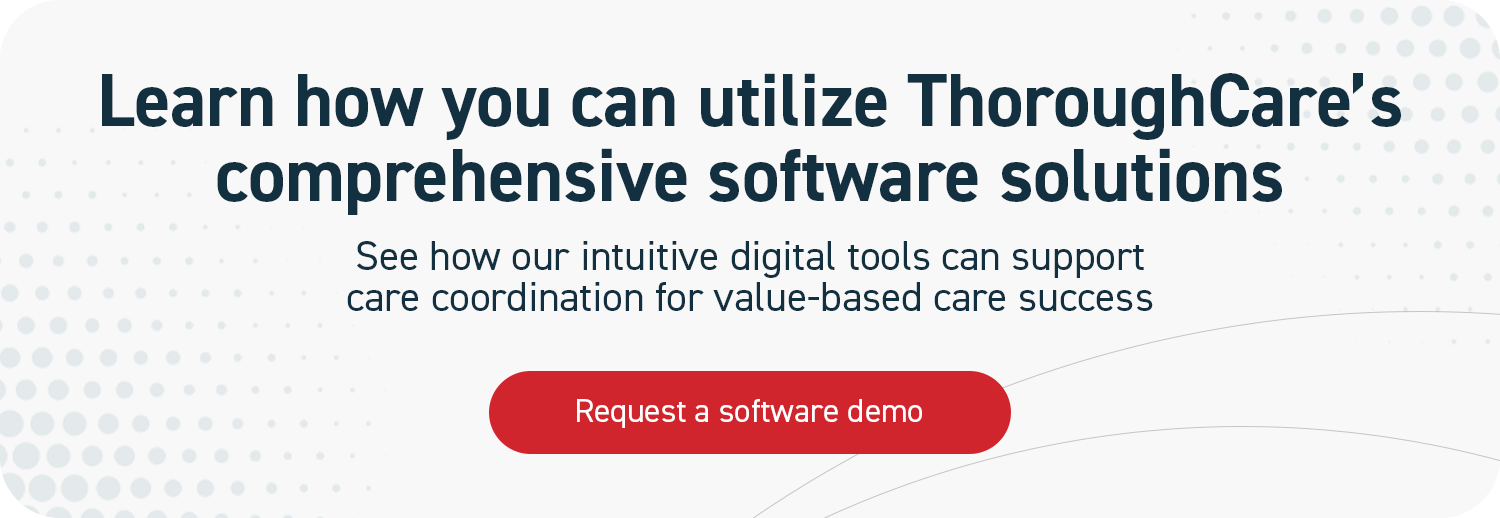How to Optimize Care Management Workflows
“Workflow” often means “how you get needed work done.” But there is more science, discipline, and skill behind optimizing care management operational workflows.
An effective (i.e., achieving a desired outcome) and efficient (i.e., reaching maximum productivity with minimum effort) workflow requires three parts with key elements, as shown in Figure 1.

Figure 1: Three parts of workflow: Input – Transformation – Output.
Input includes the resources, information, or materials needed to initiate and complete a step or task in a timely manner. A care management workflow might require the following:
- Information or data – e.g., medical diagnoses, medication lists, assessment data, SDOH needs, gaps in preventive care, date of last appointment
- Staff – e.g., clear roles, capacity or time to carry out tasks, skills or capabilities to complete steps, knowledge of processes and systems
- Tools or technology – e.g., software, evidence-based assessments, data analytics or AI functions
Transformation includes the clear and defined actions, procedures, or steps taken to modify or leverage the input to achieve the desired outcome. A care management workflow might require the following:
- Standards and policies – e.g., Transitional Care Management’s required timelines and deadlines, triggers for when to escalate to a physician/clinician, documentation or minimum monthly time requirements
- Processes and tasks – e.g., checklist of steps to take when conducting monthly Chronic Care Management patient calls, tasks to complete in preparation for patient calls, documentation, and notes summary after patient calls, care coordination steps to submit referrals
Output includes the final product, result, or outcome created through the transformation process. A care management workflow might require the following:
- Clear and understandable objectives and desired outcomes – e.g., performance goals, clinical and operational metrics, data analytics, and reporting
- Workflows linked to other workflows – e.g., current workflow may be a set of steps within a larger workflow
- Completion of steps to reach desired outcomes or objectives – e.g., current workflow might achieve desired outcome
What leads to ineffective care management?
Several factors can impact workflow efficiency and effectiveness.
Without intervention, these influences can derail patient progress while also limiting a care management program’s potential for scale, growth, and profitability.
The top reasons we see for inefficient and ineffective workflows include:
- Absence of clear goals or desired outcomes
- Inaccessible, untimely, or nonexistent information, data analytics, or reporting
- Lack of integrated data sources
- Insufficient standards or inconsistent processes
- Ineffective or no digital tools for care coordination or program management
- Dearth of staff training and confidence
- Deficient performance tracking, data analytics, or improvement feedback
- Inadequate knowledge or standards of compliance requirements
What does a broken care management workflow look like?
Performance concerns may be deemed issues with staff behavior, lack of resources, or inefficiency. Many times, these challenges are actually caused by ineffective workflow.
These issues can manifest as inconsistent care delivery, high rates of care gaps, administrative burden, and disengaged patients. Figure 2 highlights various care management problems and potential workflow areas for improvement.

Figure 2: Connecting workflow problems to care management areas of improvement.
One way to make the connection between program performance and workflow issues is to ask care managers to participate in a self-assessment. Figure 3, below, provides a workflow tool that can help care managers identify attitudes and issues surrounding various aspects of care management, including:
- Time management and prioritization
- Patient information and documentation
- Operations and standardization
- Patient engagement and effectiveness
- Skills and confidence
Helping frontline staff identify their day-to-day frustrations, barriers, and sticking points offers valuable input. Armed with this information, leaders can ask strategic questions, such as:
- Could aspects of workflow (input, transformation, or output) be a cause?
- What workflow areas connect to these challenges?
- Where could workflow optimization analysis and experimentation deliver potential improvements?
Example: Care manager workflow self-assessment
For each statement below, rate yourself on a scale from 1 to 5:
1 = Strongly Disagree | 2 = Disagree | 3 = Neutral | 4 = Agree | 5 = Strongly Agree

Figure 3: Care manager workflow self-assessment.
Reflection Questions
- Which areas scored the lowest (1-2) for you, indicating areas you feel are working well?
- Which areas scored the highest (4-5) for you, indicating areas you believe improvements should be made?
- Which 3 or 4 areas are most important for you or your team to improve?
- What tools or support would help you be more efficient and confident?
What should an optimized workflow look like?
It’s helpful to have a vision of what’s possible when focusing on care management workflows.
Below, you’ll see different workflow stages as a program progresses in maturity. These stages are defined by various qualities and processes.
Unstructured
Defined by:
- Ad hoc operations & workflows
- Manual processes
- Limited or no tools
- Inconsistent care delivery
- High rates of errors & care gaps
- Clinicians spend most of their time on manual tasks
- High burnout due to inefficiencies
Foundational
Defined by:
- Basic workflows
- Lack consistency
- Some KPI tracking
- Reactive compliance
- Consistency improves
- Reduced variability
- Staff trained on workflows
- Identified inefficiencies
- Moderate reductions in care gaps
Organized
Defined by:
- Documentation for most processes
- Regular staff training
- Routine KPI tracking
- Consistent care delivery
- Reduced care gaps
- Increased patient follow-up
- Improved engagement rates
- Staff confidence grows
Streamlined
Defined by:
- Fully documented workflows & policies
- Integrated tools & analytics
- Staff trained & engaged
- Proactive, routine compliance checks
- Improved patient adherence
- Reduced readmissions & ED visits
- Increased staff satisfaction
- Reduced admin burden
- Positive ROI
- Meeting some performance & outcomes goals
Optimized
Defined by:
- Leadership-aligned strategy
- Seamless integration of workflows, tools, and analytics
- Data-driven decision making
- Predictive care planning
- Increased preventive care
- Reduced exacerbations
- High patient satisfaction
- Clinicians focus on high-risk patients
- Achieving most performance and strategic clinical goals
Based on the care manager’s self-assessment and review of the program's progress descriptions, leaders should identify where they stand in this trajectory and what areas require additional focus. Ideally, over time, a provider would develop their program to an optimized state.
How to optimize workflow for capacity and outcomes
There are two ways to help a new or existing care management program reach higher levels of maturity, efficiency, and output.
Set up a new program for success
A program can be built for success from the beginning.
At ThoroughCare, we help clients build care management best practices through our 120-day Playbook. This helps guide newcomers through the first four months of onboarding, setup, and training.
Month 1: Covers the foundational elements of care management delivery, including:
- Platform training
- Program rules and regulations
- Setting up the appropriate team
- Suggested workflows and templates
- Partner contract samples
- Guidance on identifying the right patient population to enroll
Month 2: Focuses on advancing patient engagement via motivational interviewing tactics and quality audit preparation. We offer motivational interviewing techniques outlined in educational videos, as well as steps to conduct quality checks, identify areas for improvement, and ensure compliance with program guidelines.
Month 3: Details a 12-step guide to expanding your provider network and patient engagement through partnering. We also provide a list of common conditions with our suggested outline of care, including:
- Contents of a clinical assessment
- Recommended gaps in care
- Recommended numbers to track
- Recommended care plan, including goals and interventions
Month 4: Highlights best practices to evaluate the clinical effectiveness of your patient population via program data collected through ThoroughCare’s software platform. Analytics will guide informed decisions to optimize resource allocation and ensure the program positively impacts the health of its target population.
Assess an existing program to streamline workflow
An existing care management service can also be enhanced.
To do so, analyze workflow challenges to identify areas for focus. ThoroughCare’s Clinical Advisory Team offers an opportunity analysis that evaluates current workflow efficiency, patient engagement, and compliance practices.
Based on this assessment, the team can highlight key issues and solutions, recommending strategic next steps that may include:
- Updating policies and standards
- Implementing new tools or platform features
- Adopting AI capabilities
- Establishing a structured patient engagement framework
- Training care managers on best practices, skills, and competencies
- Utilizing automated KPI tracking, billing best practices
- Optimizing accurate time tracking and documentation
ThoroughCare’s Clinical Advisory Services optimize workflow, quality, and outcomes
Through ThoroughCare's platform and advisory services, providers and care management service companies can create, optimize, and expand a more effective and efficient program.
The team’s experience and expertise help organizations build competency, maintain compliance, and streamline operations to turn their care, patient, and financial goals into reality.
Key questions answered
How could my care management program benefit from optimizing workflows?
Optimizing care management workflows can achieve numerous objectives, including:
- Delivering timely care
- Enhancing patient engagement and adherence
- Streamlining care team communication and collaboration
- Maximizing the number of patients effectively managed per care manager
- Increase the number of enrolled patients
- Address care gaps and achieve more patient goals
- Scale and grow existing programs
- Increase capacity to add new care management programs
- Enhance billing, documentation, and general compliance
- Achieve quality and health performance measures




